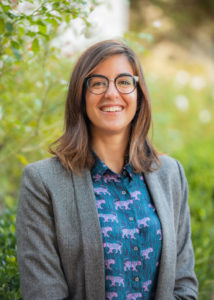
Sandra Bogetic
The department welcomes Sandra Bogetic to the faculty as an assistant professor. Bogetic received her PhD from the Department of Nuclear Engineering at UC Berkeley in 2020 as the Lawrence Livermore National Laboratory (LLNL) Scholar. Her doctoral research was done within the Nuclear Science and Radiochemistry group at the National Ignition Facility (NIF).
“We are thrilled to have Sandra Bogetic join our faculty,” said Postelle Professor, Chancellor’s Professor, and Department Head Wes Hines. “Her expertise in applying innovation to computational methods presents an exciting opportunity for our students to engage with the field.”
Bogetic received a bachelor’s degree in energy engineering from the Polytechnic University of Milan (Italy) in 2011 and a master’s degree in nuclear engineering from the Swiss Federal Institute of Technology in Zurich and the Swiss Federal Institute of Technology in Lausanne in 2013.
Her previous research experiences have introduced her to the fundamentals of nuclear research fields such as computational methods and the importance of validation and verification of computational methodology. This was one of the major drivers that pushed her to inquire about possibilities that would allow her to connect computational methods—such as the Monte Carlo transport codes for neutrons—to experiments on modeling nuclear spectra.
“UT’s department of nuclear engineering is an exciting setting for my future work,” said Bogetic. “I have been impressed by the high quality of research, by the multidisciplinary approach that combines multiple knowledge in the nuclear engineering, as well as by the collaborative environment and teamwork all in line and lively interactions with many of the national institutions.”
During her doctoral research, she focused on the further development of a metaheuristic (or higher level procedure) code optimization software package for neutron spectra tailoring, a development which included extensions, modifications, and generalization of the software. The code was initially created as a part of an ongoing collaboration between UC Berkeley Department of Nuclear Engineering and LLNL/NIF, with the goal of optimizing beam-shaping assembly to model neutron spectra for forensic applications.
Specifically, her goal was to develop a general-purpose nuclear engineering code that is flexible enough to accommodate different transport engines, HPC architectures, modeled geometries, objective functions, and constraints, all of which could significantly broaden the variety of applications in many nuclear-science related fields for neutron source facility as NIF by shaping the neutron spectra.
She also had the exciting opportunity to work at NIF in planning and designing several integral validation experiments for the materials of interest. The experimental work allows researchers to benchmark or validate design tools and quantify uncertainties based on comparisons to measurements.
The code simulations were in fact compared with the measured data and the metaheuristic optimization code has been further modified in order to satisfy the needs of NIF and other facilities. This experience broadened her knowledge on the concept of validation, uncertainties, and the use of different spectroscopic methodologies to measure neutron flux and reaction rates.